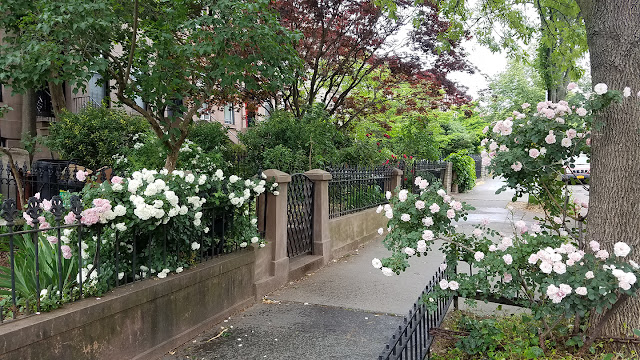The jungle. In the foreground is my row of Asclepias syriaca, common milkweed, a forager's gardening experiment.
It is just beyond midsummer, and the days are growing minutely shorter even as they grow hotter. We have had more sun than I had anticipated at this time of year, and I have been able to grow more crops than I had hoped. Like beans. Grow Journey sent me two different bush beans, part of my January and May seed-of-the-month membership.
These Painted Pony bush beans arrived first, in January, when winter still had us in its very dark and depressing grip.Summer beans seemed like a fantasy, back then. But they were very pretty.
And then the sun came. The vegetable plot receives about six hours of sun right now, which is borderline for many vegetables, but I learned in Harlem that climbing beans can thrive in four hours of sun. So I planted the Painted Ponies in early June, after taking out the fava beans and the first sowing of arugula, which had bolted faster than we could eat the tender lower stalks.
I find bean flowers very pretty, so there is the extra, ornamental boost.
Dragon's Tongue bush beans, above, arrived next, and they are growing tall, already.
As always, if I forget something about my seeds, I log into my member dashboard on the Grow Journey site and can see previous months' seeds listed, as well as detailed information about how to grow them in my Grow Guides.
Bush bean-growing is new to me, although I remember my mother's very healthy bushes in Bloemfontein, when I was little. And the snap and itchy green taste of eating the beans right out of the garden.
Some beetle is eating holes in the Dragon's Tongue leaves, and I should get some beer again for traps, in case it's a slug, not a beetle. Aaron von Frank wrote a lovely tip-of-the-month piece about how to work with insects on the Grow Journey blog - I have found it helpful. He quotes one of my gardening principles, which is actually part of the Hippocratic oath: First, do no harm.
Counter intuitively, the gardening industry is not very green at all. From the thoughtless use of pesticides and herbicides, to overuse of synthetic fertilizers like Miracle Gro (not to mention their manufacturing process), from phosphorus runoff into waterways which causes dead zones in the ocean, to the mass production of plastic pots, to the destruction of peat bogs, to the planting of highly invasive species.
What are we thinking? In short, many gardeners are not. Thinking, that is.
I am still surprised when gardeners tell me they do not grow organically (even as I am still learning more about permaculture practices and their benefits). Aaron writes in that article about the no-till method by comparing it to the effect a tornado has on a house, and how digging into the soil destroys the habitats of beneficial insects and microorganisms.
AND I have just learned that firefly larvae live for two summers before becoming fireflies (we have dozens every night now) and eat insects like aphids! The adults do not eat.
Finally, the Thai basil is a small forest, now. I planted it in one of the shadiest spots near the house, in two gifted troughs from my friend Julia. I was not sure how it would do. But the plants are growing sturdier, and are now sharing space with some sprouting ginger plants, another experiment.

































